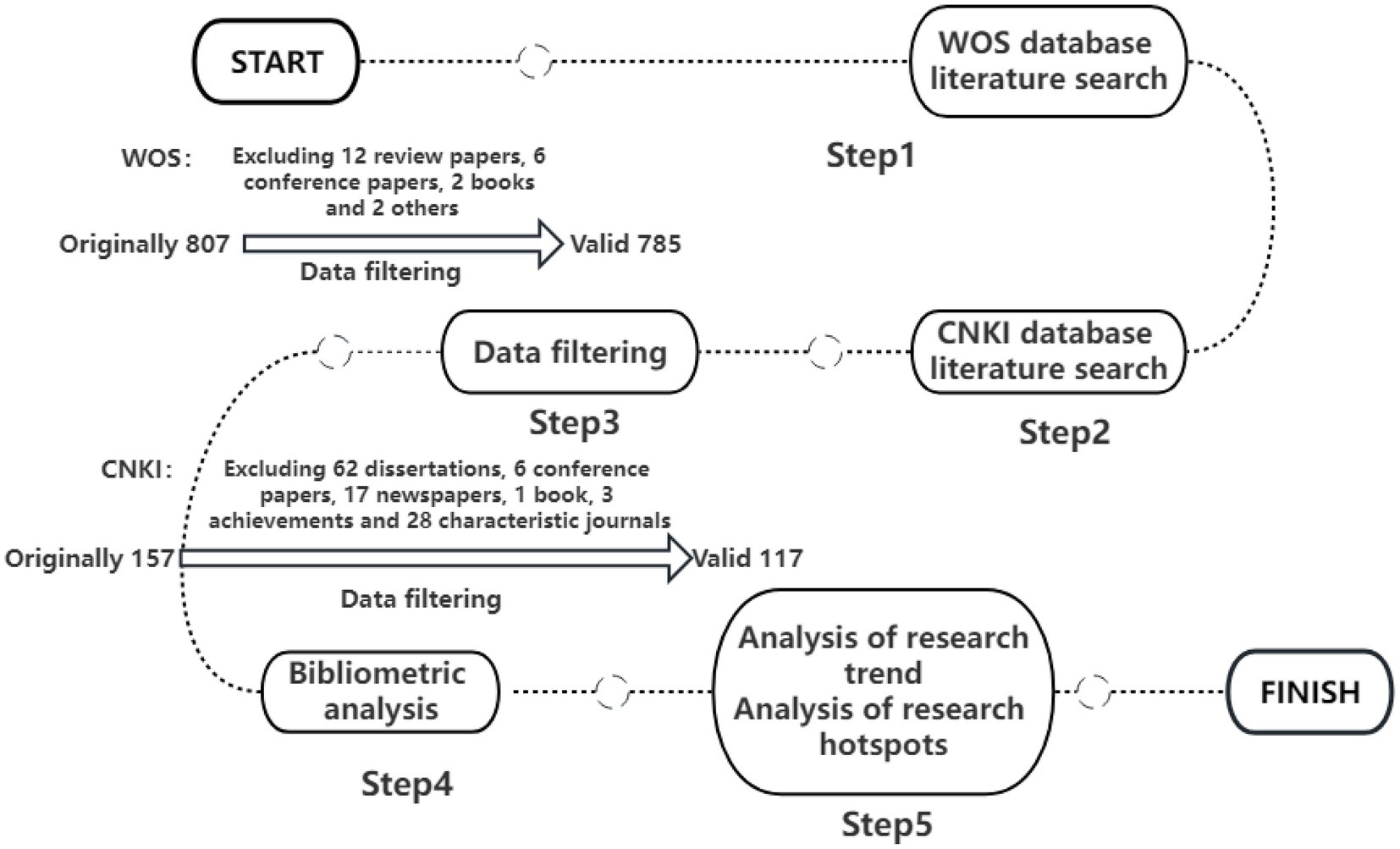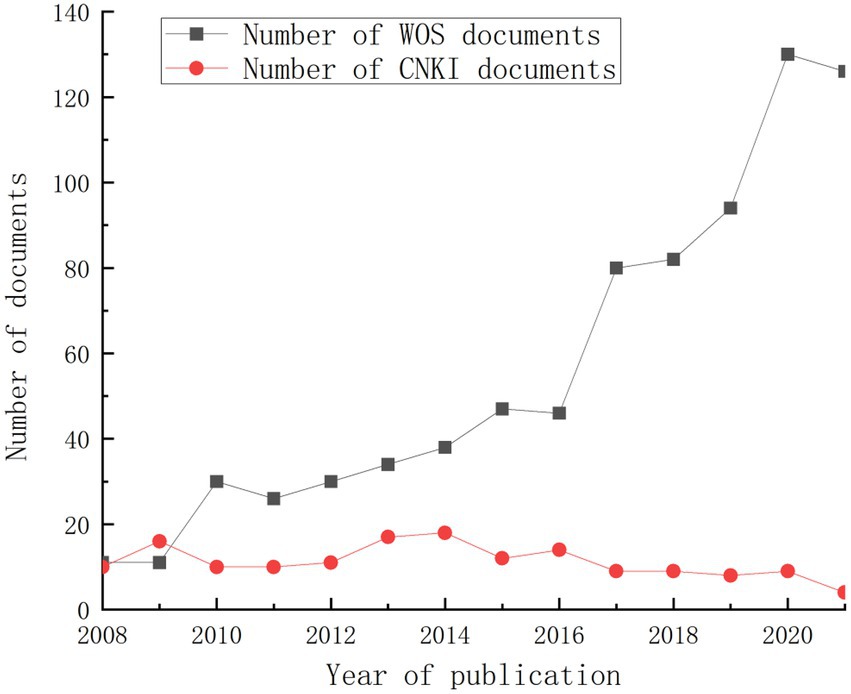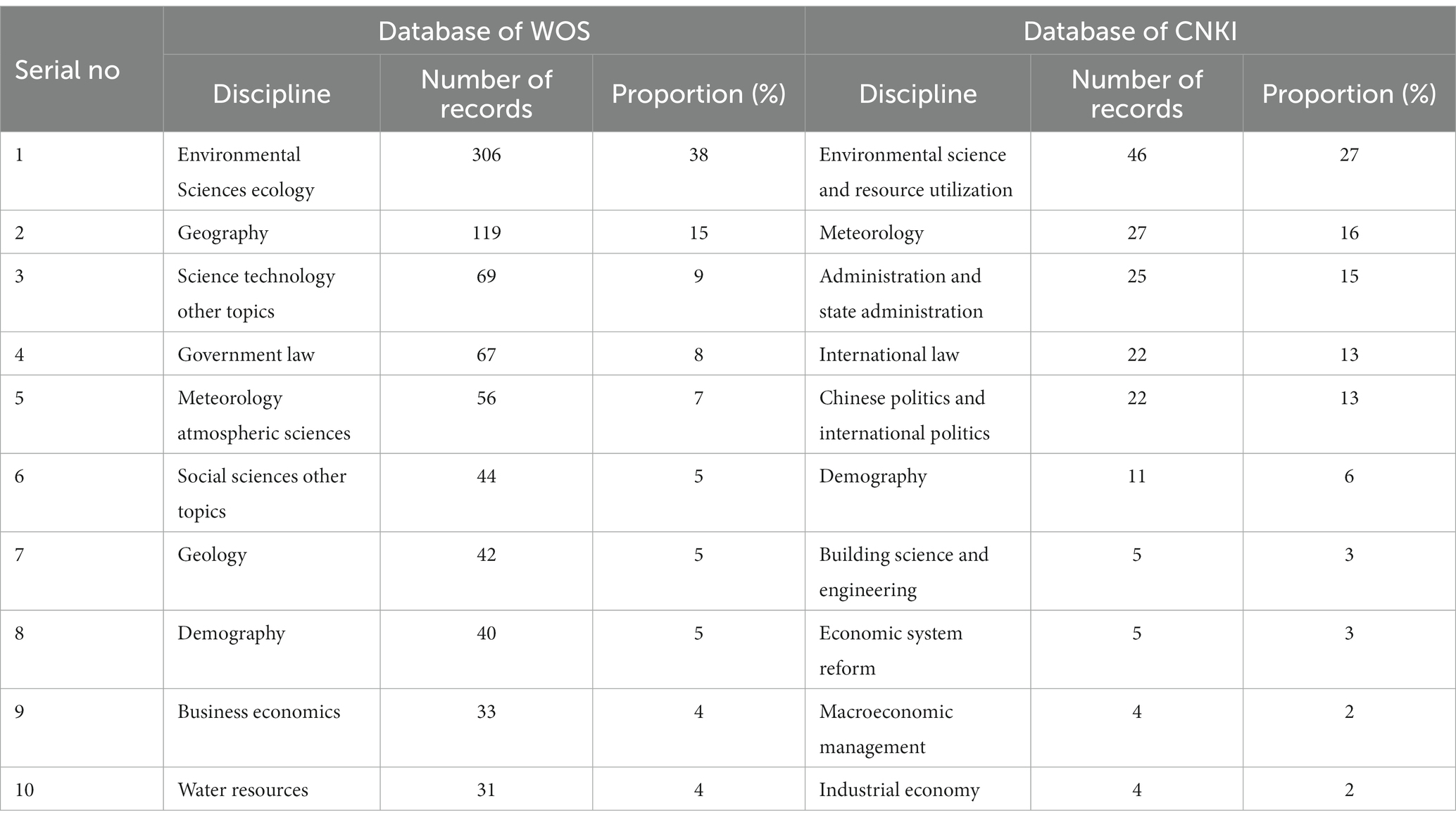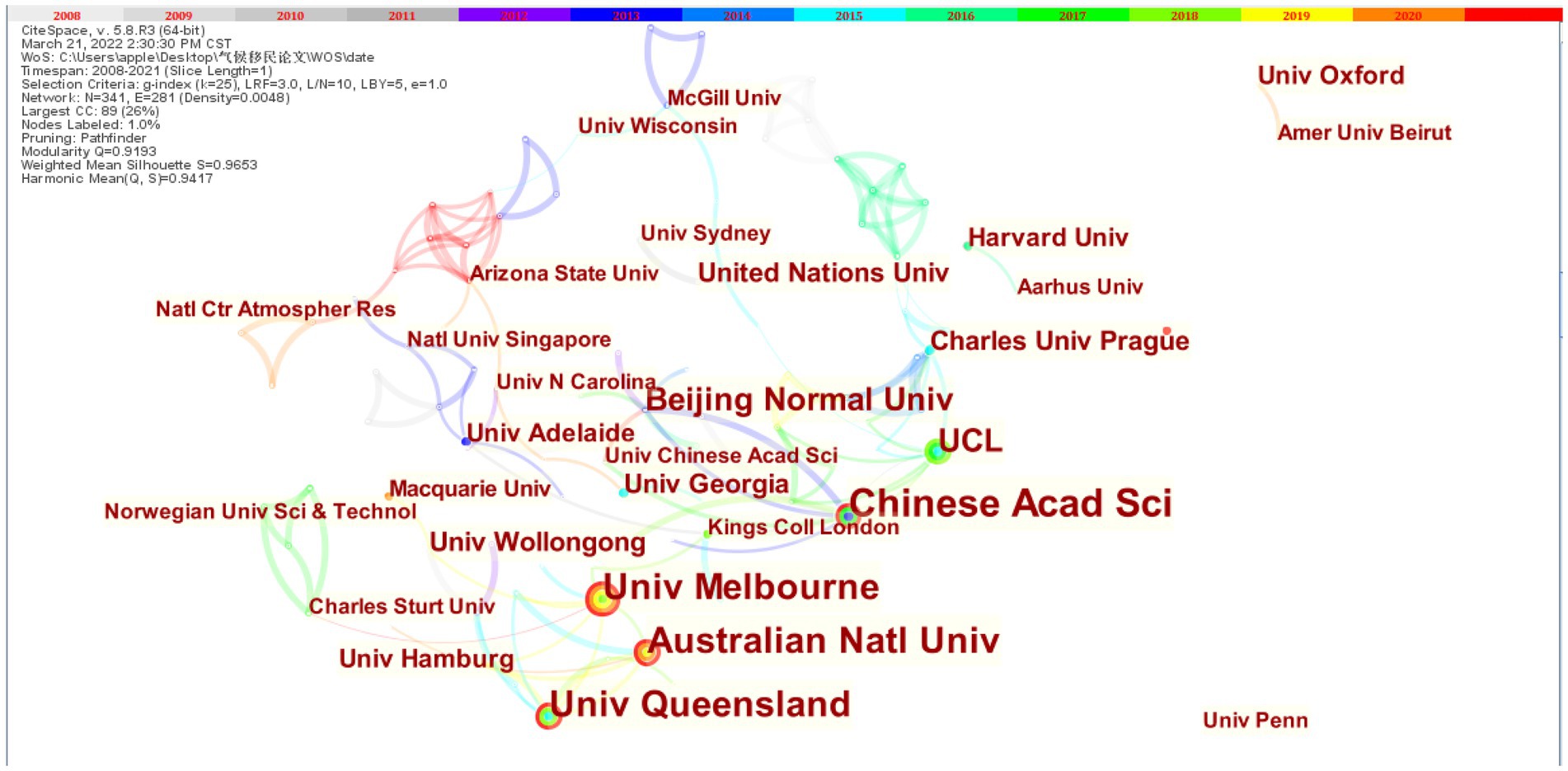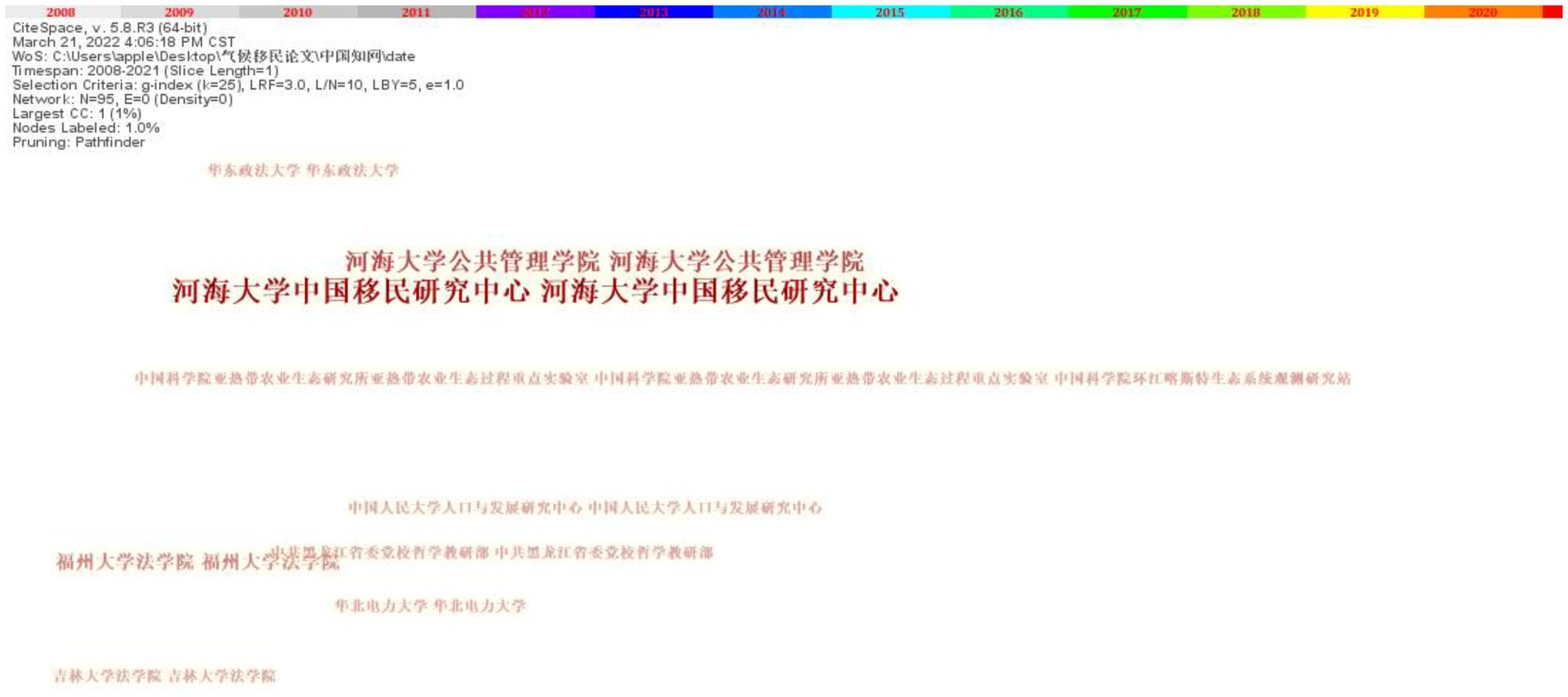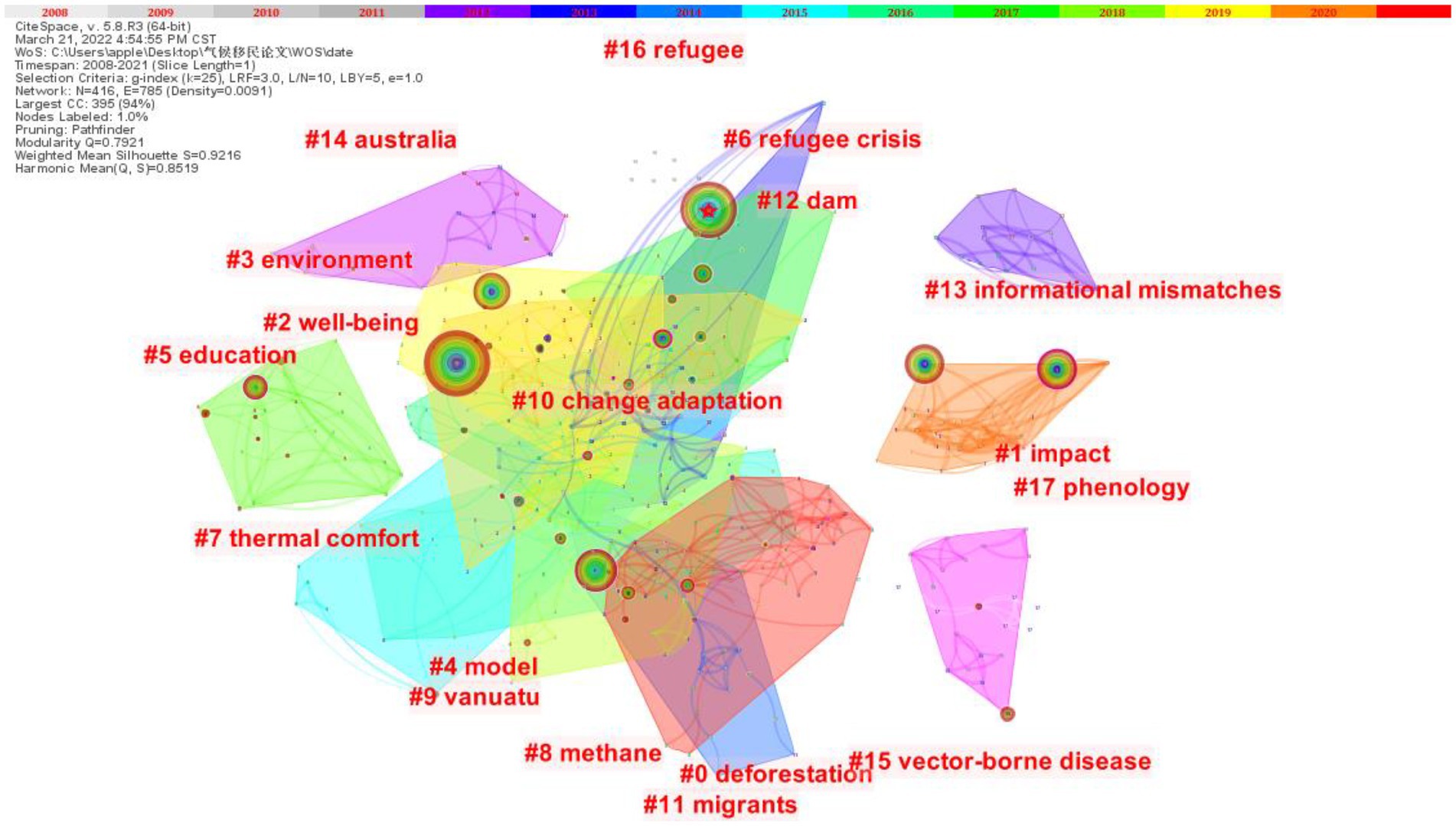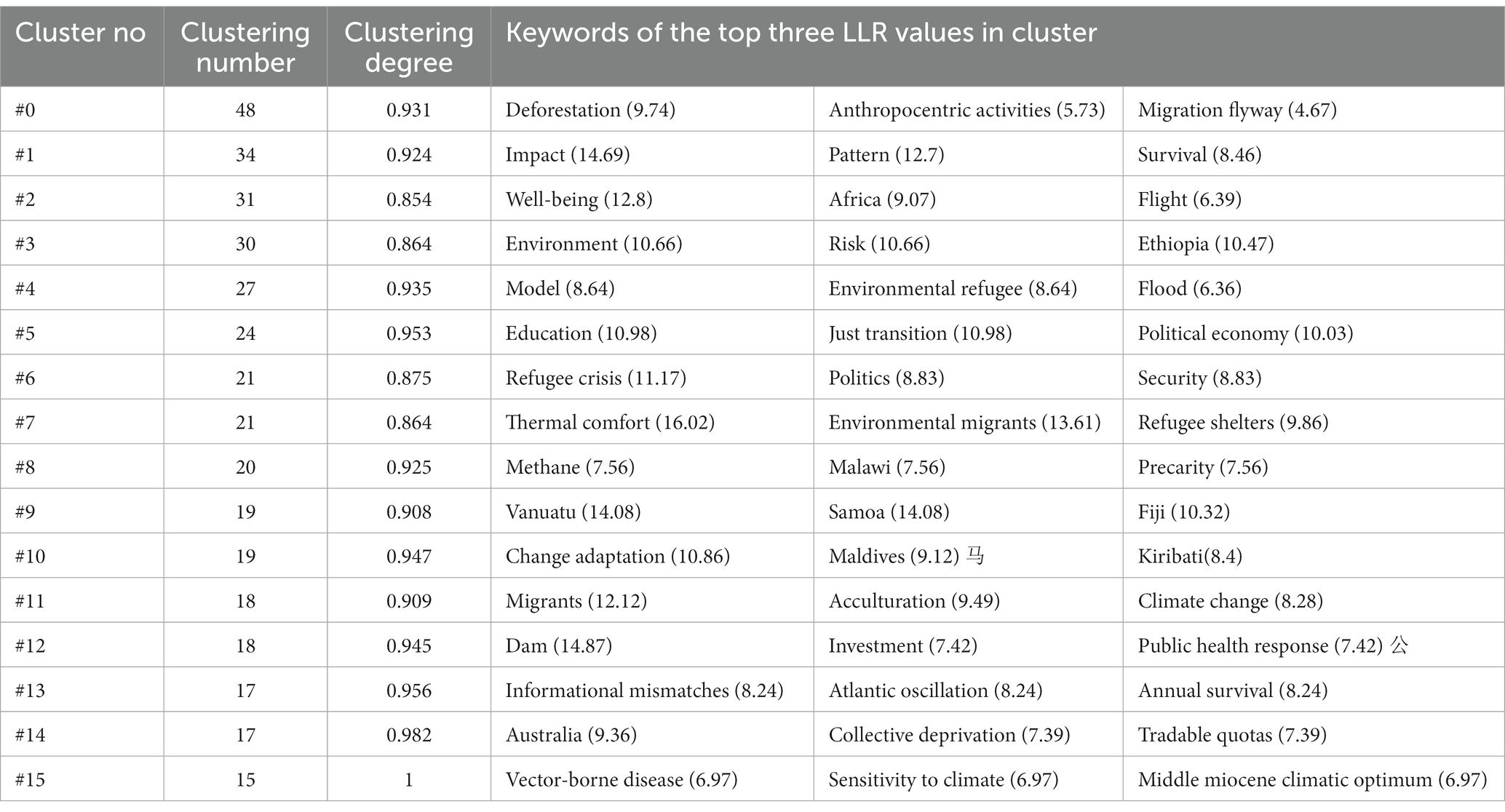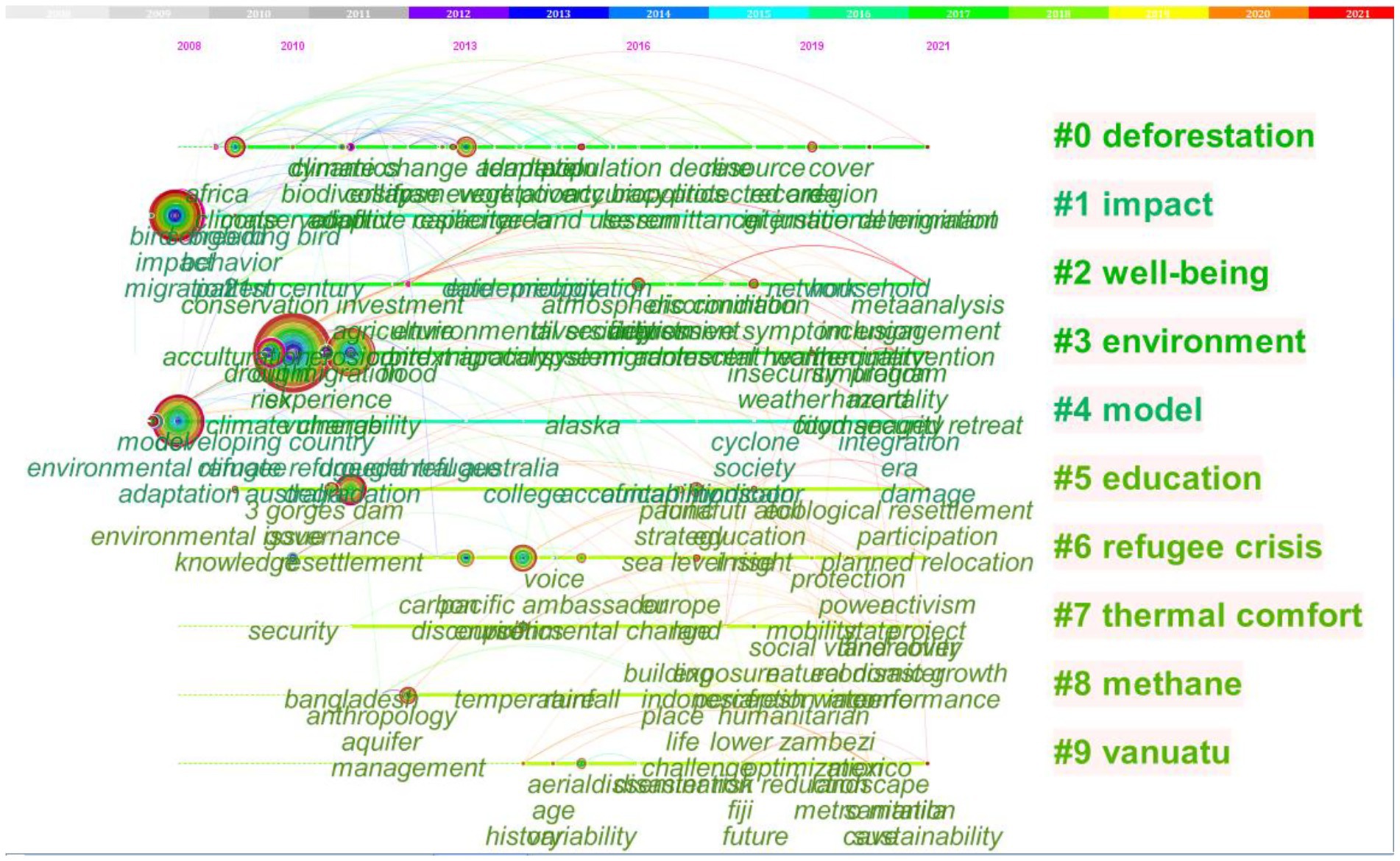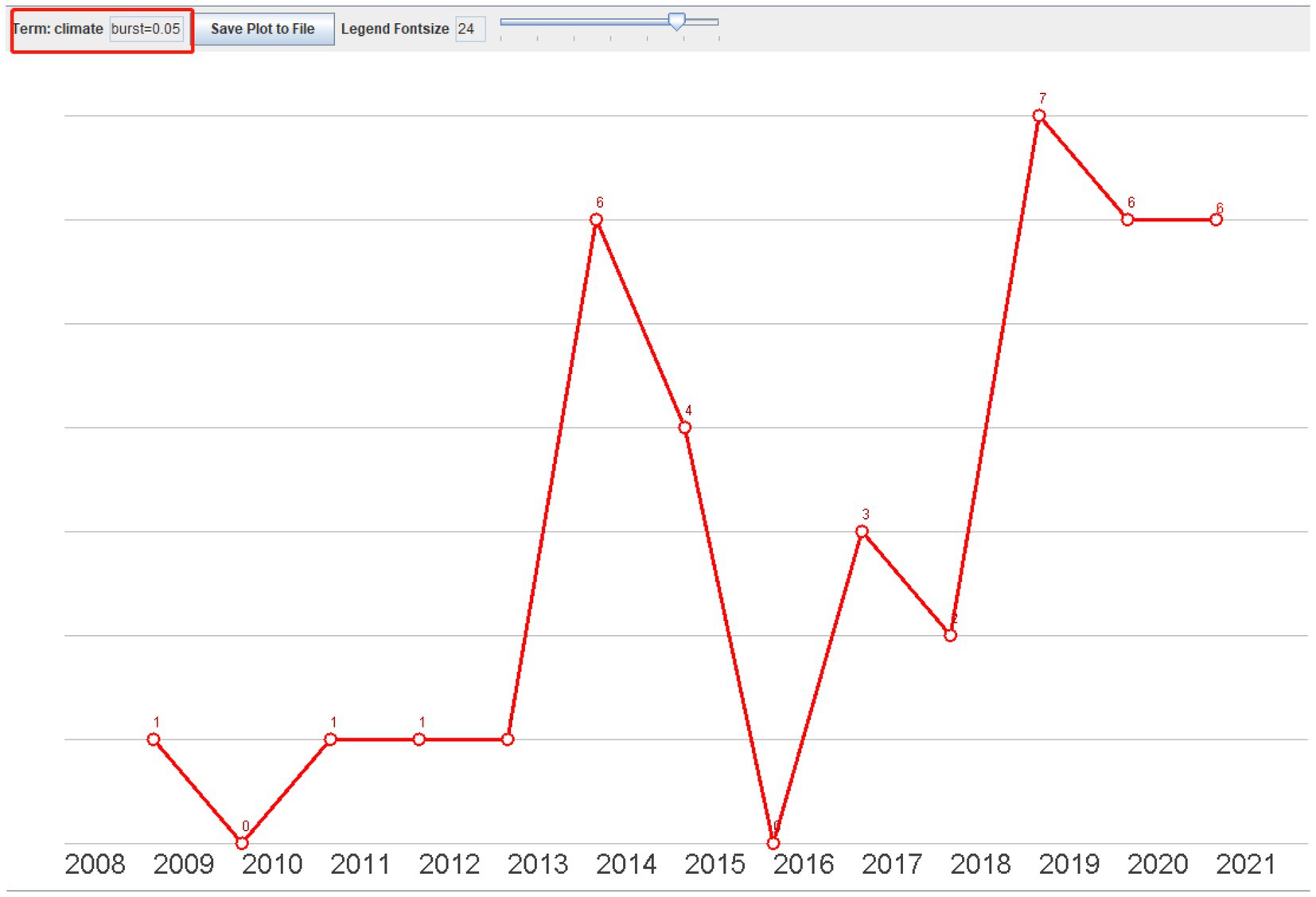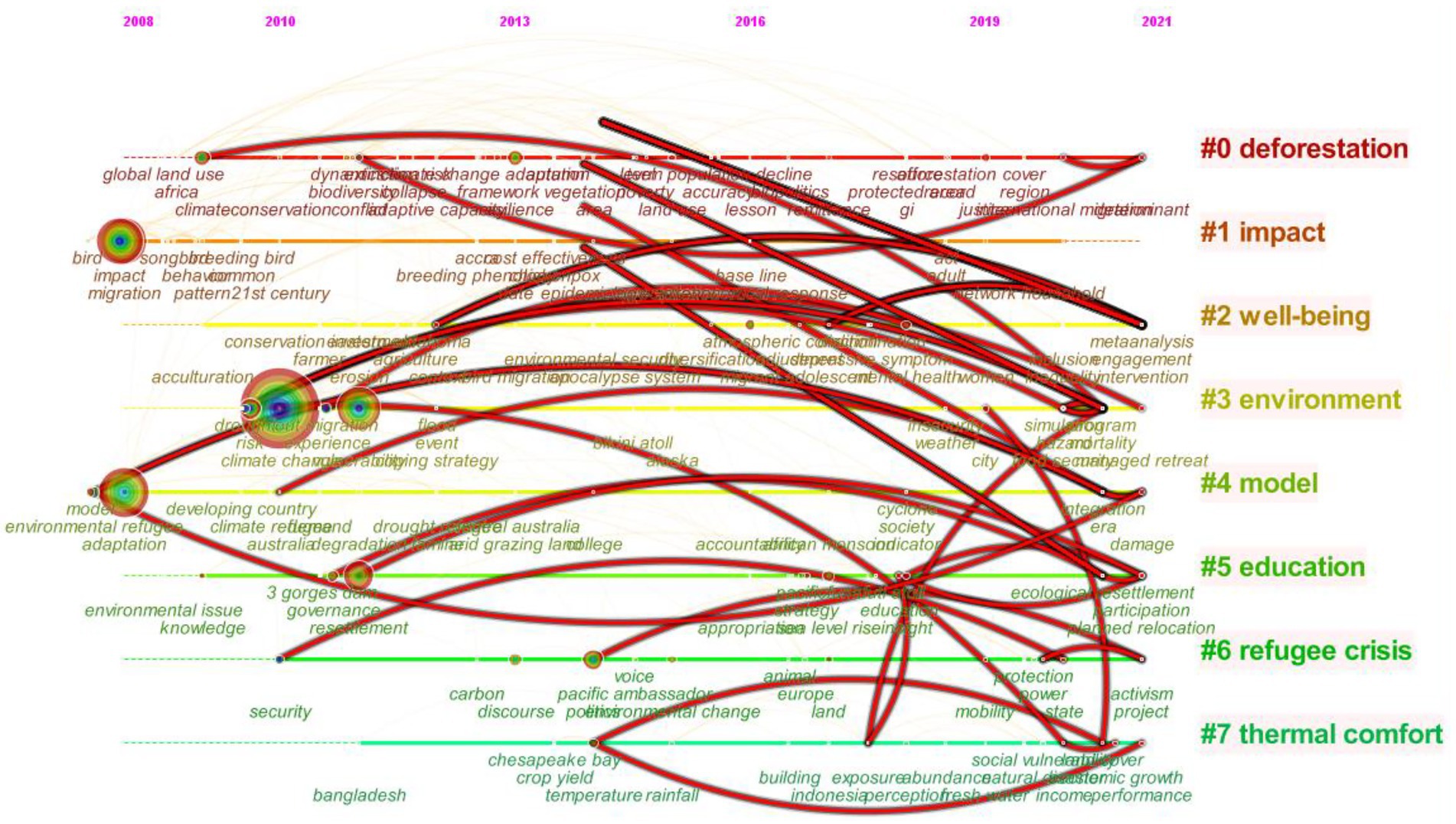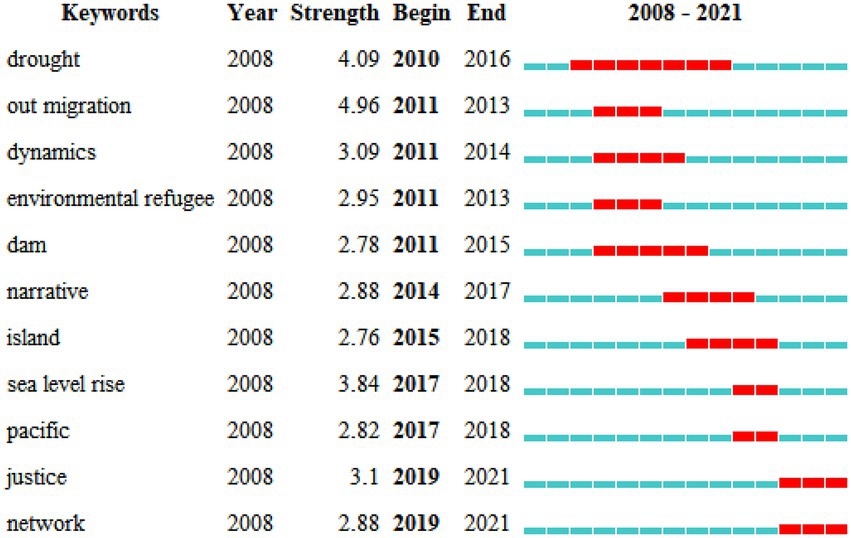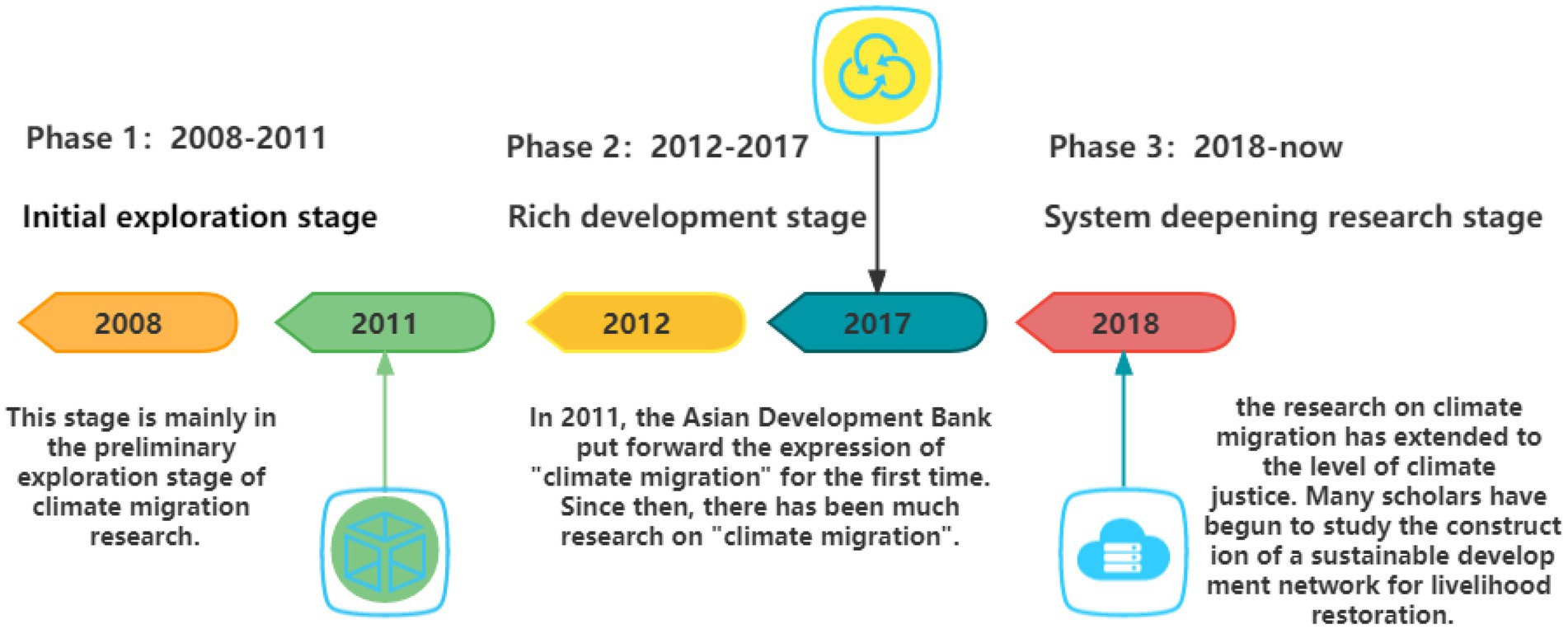- 1National Research Center for Resettlement, Hohai University, Nanjing, China
- 2Institute of Social Development, Hohai University, Nanjing, China
- 3Asian Research Center, Hohai University, Nanjing, Jiangsu, China
- 4Media College, Soochow University, Suzhou, Jiangsu, China
Introduction: Global climate change, which is characterized by climate warming, has become one of the most prominent risk problems in society at present. Climate migration brings many accompanying problems to the environment, economy, politics, society, and culture. It is of great theoretical and practical significance to study the internal relationship between climate change and population migration.
Methods: The data were extracted from the Web of Science core collection database (WOS) and China Knowledge Network database (CNKI). A total of 785 documents and 157 documents in the field of climate migration from 2008 to 2021 were selected as analysis samples. Word frequency analysis, clustering analysis, sudden word detection analysis, and other methods were extensively used to build the evolution trend map of climate migration using CiteSpace visual bibliometric software.
Results: It is concluded that climate migration research has experienced three stages of development: initial exploration stage (2008-2011), development enrichment stage (2012-2017), and system deepening stage (2018).The hot topics of climate migration include: (1) different types of climate migration research; (2) Quantitative model research on climate migration; (3) Climate justice research. Different types of climate migration include 7 main types: (1) migration caused by sea level rise; (2) Resettlement caused by flood disaster; (3) Migration due to worsening drought; (4) Migration caused by extreme climate events; (5) Voluntary migration due to climate change discomfort; (6) Project resettlement caused by climate change response engineering measures; (7) Migrants whose livelihoods are broken due to climate change.
Discussion: The study points out that climate migration research is an interdisciplinary research field, which needs joint research by scholars from different academic backgrounds. In the future climate migration research, 1) strengthen the prediction ability of climate change population migration model; 2) Make use of China’s beneficial exploration in the migration fields such as engineering resettlement, ecological resettlement and poverty alleviation resettlement to formulate climate migration policies, regulations and strategic planning; 3) Establish a database cloud platform related to climate change and population migration; 4) Strengthen the exchange and cooperation between Chinese researchers in the field of climate migration and international scientific research institutions.
1. Introduction
Climate change, along with its adverse impacts (Da Silva Espinoza et al., 2023), have triggered many actual or potential climate migrations (Black et al., 2011). Humanitarian crises, refugee flows, regional conflicts, and other issues caused by climate migration are increasingly attracting the attention of governments and the international community. They have become one of the core issues of universal concern to human society at this stage (Ionesco et al., 2016). With the change in the global climate model, the increase in the certainty of global warming has led to a shift in the direction of the Earth’s ocean current, which has led to the continuous rise of the tropical ocean surface temperature, the prolongation of the duration and intensity of global ocean storms, the increase in sea levels, the intensification of desertification, and the frequent occurrence of drought and flood (Oliveira et al., 2022). As a result, the climate has become extremely volatile (Morley et al., 2020). An extreme climate has spawned a large number of “climate migrants” who have had to migrate due to climate change, ecological imbalance, geological variation, and environmental pollution (Daoudy et al., 2022). Steve Trent, President of the Environmental Justice Foundation, pointed out that “climate change will affect families, infrastructure, food, water, and human health, and will also lead to unprecedented large-scale population migration”(Trent, 2022).
In 1990, the Intergovernmental Panel on Climate Change (IPCC) pointed out in its report that “one of the most serious consequences of climate change is to affect population mobility (Houghton, 1996). Nicholas Stern put forward a clear message in the “Stern Review on the Economics of Climate Change (2007)”: Climate change is a severe problem, and the earth’s climate is changing rapidly, mainly due to the increase in greenhouse gases caused by human activities (Stern and Stern, 2007; Da Silva et al., 2023). In addition, the report proposes another view: the poorest countries will be hit hardest by climate change. Some regions are more vulnerable to these adverse factors than others. Generally, mitigation or adaptation is considered the only possible solution to these problems. However, those areas that are already extremely poor and vulnerable before the impact of climate change will not be able to mitigate or adapt to climate change in the usual sense. Therefore, people’s only hope is often to move from a habitable area to an area that may give them better living conditions (Stern and Stern, 2007). An increasing number of studies have shown that climate migration caused by climate change is a significant problem that mankind will face in the future (Heltberg et al., 2009; Burrows and Kinney, 2016).
On February 28, 2022, the sixth assessment report released by the IPCC emphasized that the average temperature of the Earth’s surface increased by approximately 1°C in the 50 years from 1850 to 1900 (IPCC, 2022). According to the current data, the global temperature will increase by more than 1.5°C in the next 20 years (Pörtner et al., 2022). Mr. Zhai Panmao, cochairman of the IPCC, pointed out that “climate change is affecting all regions in different forms, and this impact will be further intensified with the continuous rise of temperatures”(Wang et al., 2022). When the temperature rises by 1.5°C, the warm season will be prolonged, and the cold season will be shortened. When the temperature rises by 2°C, the incidence of extremely high temperature weather will increase exponentially, reaching the tolerance threshold of agricultural production and human health. Climate change has different combined impacts on different places, and these impacts will be more far-reaching with the increase in temperatures. For example, climate change will intensify the global water cycle, which means that strong rainfall will be generated, resulting in floods, but drought may occur in other regions (Cui et al., 2021). Entering the 21st century, sea levels will continue to rise, devastating island countries and coastal areas (Goodell, 2018).
On March 1, 2022, the “China Climate Bulletin 2021” issued by the China Meteorological Administration showed that China has high precipitation, high temperature, significant warm and humid characteristics, frequent extreme weather events, and a poor climate. The annual average temperature across the country hit a new record high, with the high temperature lasting for a long time and ending late. In 2021, the annual average temperature in China will be 10.5°C, 1.0°C higher than that in 1981–2010, which is the warmest year since 1951. The rising temperature has led to the rise of sea levels, which has changed the land use in China’s coastal areas. Climate change may cause significant changes in the occurrence rules of flood and drought disasters in China and increase the frequency of extreme climate disasters. Therefore, it is highly imperative to do an excellent job in coping with climate disasters and overall planning for disaster avoidance and migration. However, the research on climate migration in China is weak, the research results are relatively scarce, the climate migration policy has not been formulated, and the practice of climate migration lacks technical guidance and systematic theoretical guidance (Wickramasinghe and Wimalaratana, 2016). Due to different national conditions and regions, the existing theories, models, and practical experience of climate migration need further comparative research, innovation, and development. Therefore, to discuss the current research situation in the field of climate migration at home and abroad, climate migration-related literature for quantitative analysis was used to analyze the evolutionary path and hot topics in the field.
Global climate change, characterized by climate warming, has become one of the most prominent risk problems in society at present (Bizuneh et al., 2022). Whether people migrate to cope with climate change or climate migration brings many accompanying problems to the environment, economy, politics, society, and culture, it is of great theoretical and practical significance to study the internal relationship between climate change and population migration. How to improve people’s understanding of population migration caused by climate risk and analyze the main factors that cause climate migration based on existing research have become urgent issues. Since the 1980s, the international community has gradually paid attention to the issue of population migration related to climate change, while domestic research results on the global environment, climate change, and population migration are relatively few. This paper combs some important issues in the field of climate migration, points out the current research trends in this field, and provides research ideas for scholars in the field of climate migration.
2. Research method
2.1. Data sources
The data used in this study are from the WOS database and CNKI database. CNKI, founded in June 1999, is an authoritative academic platform in China. It is the concept of national knowledge infrastructure, which was proposed by the World Bank in 1998. CNKI project is an information construction project aimed at realizing the dissemination and sharing of knowledge resources in the whole society. CNKI has developed into an international leading online publishing platform integrating journals, doctoral theses, master’s theses, conference papers, newspapers, reference books, yearbooks, patents, standards, Chinese studies, and overseas literature resources. The daily updated literature volume of the center website is more than 50,000. The keywords retrieved from the WOS database were “climate change induced migration*,” “climate migration*,” climate resettlement*, climate refugee*, and “environmental migration*.”1 A total of 807 documents were retrieved, with a time span of 2008–2021. Excluding 12 review papers, six conference papers, two books and two others, and 785 valid documents in WOS database were obtained. The CNKI database searches 274 studies with the subject words “climate migration,” “climate refugee,” or “environmental migration” (Guo and Shi, 2013; Yan and Shi, 2016, 2017), and the time span was from 2008 to 2021. Excluding 62 dissertations, six conference papers, 17 newspapers, one book, three achievements and 28 characteristic journals, 157 valid documents in CNKI database were obtained.2
2.2. Method
The specific research methods include word frequency analysis, cluster analysis, burst word detection analysis, etc. The specific technical software used includes Origin mapping software, CiteSpace visual literature measurement software, SPSS statistical analysis software, etc.
2.2.1. Word frequency analysis
By analyzing the frequency of the subject words in the literature, the hot topics in the discipline or research field were found and the development trend of the research hotspots were transfer through the timeline map.
2.2.2. Cluster analysis
Clustering data based on similar features were used to compare the similarity between different data. It is one of the basic tools for people to recognize the characteristics of unknown things. Following the hierarchical clustering principle, the similarity of subject words was clustered from large to small.
2.2.3. Detection and analysis of paroxysmal words
The value of a variable has surged in a short time, suddenly becoming a hot spot, which is a concern for the academic community and can be understood as the “Baidu Index.” This variable can be keywords (frequency), authors, institutions, countries (number of documents issued), references (frequency of citations), and other aspects. Through burst detection, it was found that research in a particular field shows an evolutionary trend from macro to micro, and from single to diversified. The aim was to review or predict which key branch technologies have become hot in what period, and even predict which key technologies can continue the burst trend in the future. See Figure 1 for research methods and steps. Burst detection parameter setting: the gamma value range is 0–1. The smaller the value, the greater the number of emergent words will be. The parameter Minimum represents the minimum unit of the emergence time (default: 2 years, minimum: 1 year). Again, the smaller the value is, the more emergent words there will be.
2.2.4. Analysis of keyword co-occurrence
The keywords is are the eyes of the paper and represents a high summary of the research theme of the article. Analyzing the keywords of the paper can provide a quick understanding of the research theme of the paper. There is a certain relationship between keywords in the paper. Usually “cooccurrence frequency” is used to express this relationship. The more keywords appear in the same document, the closer the relationship between the two keywords is. Keyword co-occurrence analysis analyzes the relationship between each topic in the literature set by calculating statistics on the frequency of keyword co-occurrence in the literature.
3. Results
3.1. Statistical analysis of overall literature
3.1.1. Statistical analysis by publishing time
This research is based on the statistical analysis of 785 related documents of WOS source journals and 157 related documents of CNKI source journals (see Table 1). There was significantly more research on climate migration in the WOS database than in the CNKI database, and the research on climate migration in the WOS database shows exponential growth. In contrast, the research on climate migration in the CNKI database tends to grow steadily (see Figure 2). Based on the relevant research literature on climate migration in the WOS database, the number of climate migration research papers can be divided into three stages: (1) From 2008 to 2009, the climate migration research in this stage was stable, with an average annual number of papers of 11. (2) From 2010 to 2016, climate migration research showed an upward trend, with an average annual number of 35 papers. (3) In 2017–2021, climate migration research entered a stage of rapid development, with an average annual number of 102 papers, which has become a focus of academic and social attention.
3.1.2. Statistical analysis by discipline
The discipline classification of relevant literature in the research field plays an important role in scientific research, from which the discipline classification and proportion of the research content can be analyzed. In this study, the top 10 disciplines from the climate migration literature database were selected (Table 2). The WOS database accounts for a relatively high proportion of disciplines, including Environmental Sciences and Ecology and Geography; Environmental science, resource utilization, and meteorology account for a high proportion in the CNKI database. In addition, the subjects involved in the literature in the two databases were administration, demography, and macroeconomic management. Climate migration is an interdisciplinary research field involving both natural science and social science, which puts forward higher academic level requirements for researchers.
3.1.3. Statistical analysis by core authors
Core authors play a significant role in scientific research, reflecting the level of the research field, to a certain extent, and driving research forward. In this study, CiteSpace measurement software was used to analyze the literature in the two databases (Tables 3, 4). The analysis found that the scholars Farbotko C (Farbotko, 2010, 2019; Farbotko and Lazrus, 2012; Farbotko et al., 2016, 2020; Boas et al., 2019), Kelman I (Mercer et al., 2010; Watts et al., 2015, 2017, 2018, 2019, 2021), and McNamara KE (McNamara, 2007; McNamara and Gibson, 2009; McNamara and Des Combes, 2015; Farbotko et al., 2020; McNamara et al., 2020) published more than 10 papers on climate migration research in the WOS database in the target period, belonging to high-yield scholars in the field of climate migration. In the China CNKI database, scholars Shi Guoqing, Chen Shaojun, and Cao Zhijie have published more than five articles on climate migration research in the target period. They are leading scholars in the field of climate migration research in China. Professor Shi Guoqing is not only one of the scholars who jointly published climate migration papers in Science on January 28, 2011, but also one of the Chinese scholars who published the most papers in both Chinese and English. At the same time, he also published many papers on various resettlement policies, theories, and applications, such as projects, disasters, ecology, poverty alleviation, mines, etc. (Shi, 2005; Guo and Shi, 2010). Professor Chen Shaojun has made many achievements in the field of climate migration research, systematically defined the concept and type of climate migration, performed an in-depth analysis of the migration mechanism, current situation, and countermeasures of climate migration, and creatively combed the formation mechanism and evolution trend of climate poverty (Cao and Chen, 2013, 2016; Cao et al., 2014).
3.1.4. Statistical analysis by leading research institutions
In this study, Cite space measurement software was used to analyze the cooperation network of scientific research institutions and generate corresponding maps (Figures 3, 4). The scientific research cooperation network was measured by jointly publishing papers in bibliometrics. In the cooperation network map of scientific research institutions in the WOS database, there were 341 network nodes and 281 connecting lines between nodes. Among them, the color of network nodes represents the time distribution of published literature by institutions, and the color of connecting points represents the year of the first cooperation of scientific research institutions. Chinese Acad Sci, Univ Melbourne, Australian NatlUniv, Univ Queensland, and UCL are high-yield scientific research institutions in the field of climate migration research internationally. The National Research Center of Resettlement of Hohai University is a high-yield scientific research institution in the field of climate migration research in China. These scientific research institutions have strong leadership and authority in the field of climate migration research. From the perspective of network map density, the node density of the cooperative network map in Figure 3 was 0.0048, and the density of the cooperative network map in Figure 4 was 0, indicating that scientific research institutions lack cooperation in the field of climate migration. Climate migration will become a hot research topic. China can introduce scientific research talent from the above scientific research institutions to strengthen China’s scientific climate migration research.
3.2. Analysis of keyword co-occurrence
Due to space constraints, this study selected the top 40 keywords (Table 5). The size of centrality reflects the co-occurrence of this keyword and other keywords. The top three in terms of centrality are an environmental refugee (0.34), exposure (0.34), exposure (0.34), and risk (0.31).
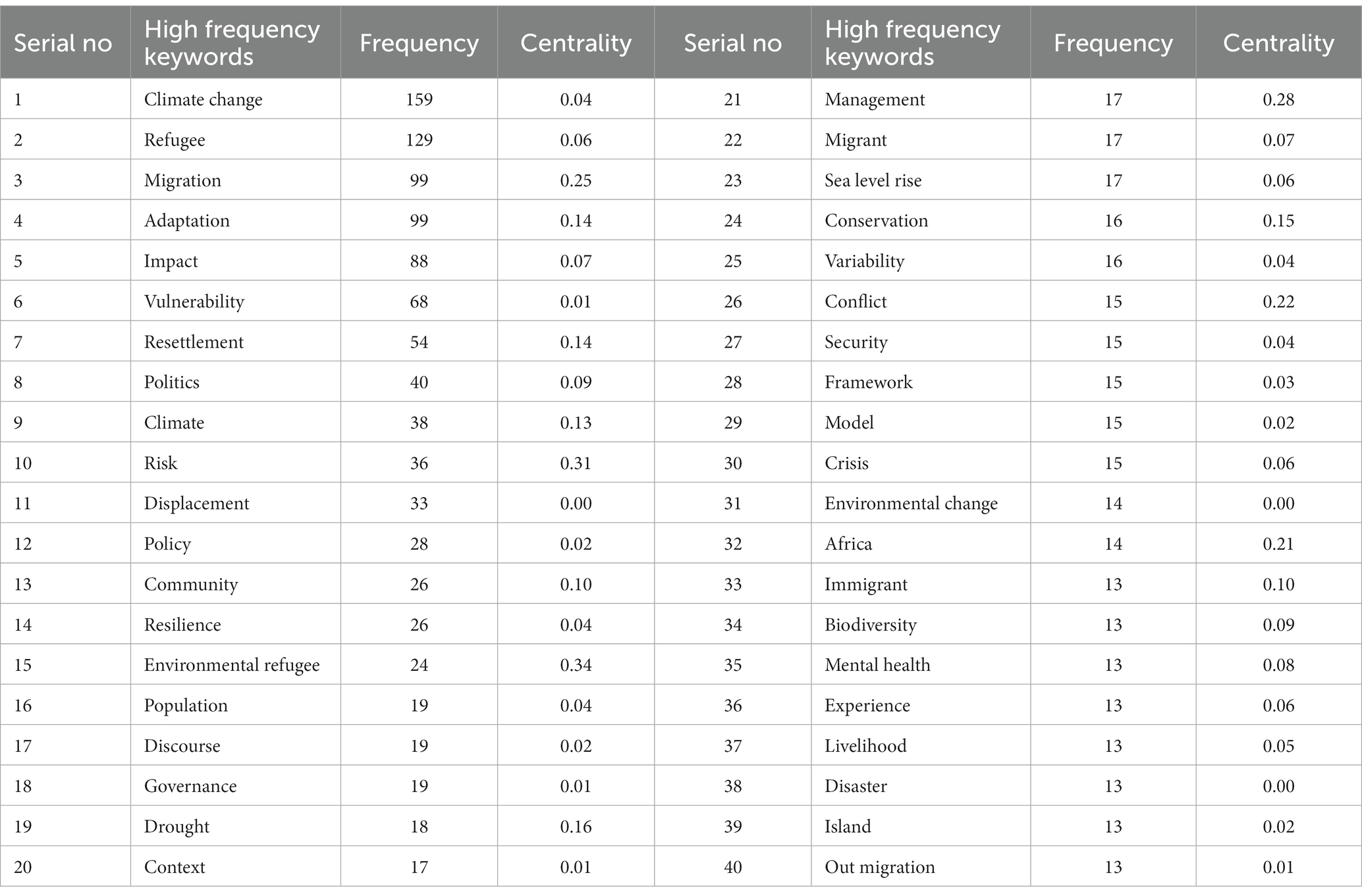
Table 5. Statistics of high-frequency keywords in the field of climate migration research (WOS 2008–2021).
3.3. Analysis of keyword cluster
Keyword clustering analysis is based on keyword co-occurrence analysis. This study uses measurement software to cluster keywords and obtains a keyword clustering atlas (Figure 5). In the keyword clustering map, two values determine whether the clustering effect is ideal. One is the Q value of the clustering module, and the other is the S value of the average clustering contour. When Q > 0.3, the clustering structure is significant; when S > 0.5, the clustering is more reasonable, and when S > 0.7, the clustering effect is satisfactory. In Figure 4, the Q value is 0.7921, and the S value is 0.9216, indicating that the keyword clustering structure is very significant and the clustering effect is satisfactory.
In this study, the log likelihood ratio (LLR) is used to extract the clustering label words of keywords. The larger the LLR value is the more representative the clustering label words are. The number of keywords in keyword clustering is greater than 10 indicating that the clustering is meaningful. According to the LLR algorithm, a total of 18 clusters are obtained. Since the number of keywords in cluster # 16 and cluster # 17 is only 8 which is less than 10 they are eliminated without analysis so that we can obtain a total of 16 effective clusters (Table 6). The number of clusters represents the total number of keywords contained in the cluster. The degree of clustering represents the similarity between the members of the cluster. The larger the number the more similar it is. For example for cluster # 0, the number of clusters is 48 indicating 48 keywords and the compactness is 0.931 indicating substantial similarity among cluster members. The keywords of cluster members in the top three clusters with LLR values are defection LLR value is 9.74; anthropological activities LLR value is 5.73; and migration flyway LLR value is 4.67.
3.4. Analysis of the timeline map
The timeline atlas is \ generated on the basis of clustering. Cluster members are arranged on the same line according to the order of the timeline. Due to space constraints, this study selects the timeline atlas of the top 10 keyword clusters (Figure 6). The timeline map is mainly interpreted from the four dimensions of “first appearance,” “hot trend,” “cold trend,” and “landmark research.” Taking cluster # 0 deformation as an example, the keyword “climate” with the highest frequency among its cluster members first appeared in 2009 (Figure 7). As shown in Figure 7, the frequency of the keyword appeared to fluctuate and increase, becoming a research hotspot. Figure 6 shows that the core keywords in cluster # 0, the deforestation cluster, are densely distributed, and the research is hot. Scholars have paid more attention to them. The distribution of core words in cluster # 8 metal is relatively small, indicating that this cluster’s research is cooling down and attention has decreased since 2011. Iconic keywords generally refer to words with high intermediary centrality. The purple keyword in the outermost circle of the key word tree ring chart is a symbolic keyword, such as impact, resilience, adaptation, etc. The evolutionary relationship of the intermediate core words between clusters over time can be clearly seen according to the evolution map of the relationship between keyword clusters. The color of the line indicates the corresponding year. Due to space limitations, Figure 8 shows the evolution map of the relationship between climate migration keyword clusters in 2021.
3.5. Detection and analysis of paroxysmal words
Here, the gamma value of the parameter is 1, and the minimum value of the parameter is 2. The keyword emergence map in the climate migration research field is obtained (Figure 9), where “Begin” refers to the year when the keyword first appeared; “End” refers to the year when the keyword disappeared; and “Strength” refers to the strength of keyword emergence. The larger the value, the more important it is. The red line indicates the duration of the keyword highlighting.
4. Discussion
4.1. Division of research stages
Based on the above analysis of the detection of unexpected words, the unexpected words in the key words can be identified within a certain period of time. Combined with their evolution and changes on the timeline, the first 11 unexpected words can be obtained. Combined with relevant literature research and expert opinions, the development trend of climate migration research was divided into three stages.
4.1.1. Initial exploration stage (2008–2011)
This stage is mainly in the preliminary exploration stage of climate migration research. It can be seen from the mutation core words “drought,” “out migration,” “dynamics,” “environmental refugee,” and “dam” in Figure 7 during this period that the concept of climate migration has not been put forward at this stage. Foreign scholars pay more attention to the study of “environmental refugees” and have carried out a series of fruitful studies on “environmental refugees” through multiple dimensions.
4.1.2. Rich development stage (2012–2017)
In 2011, the Asian Development Bank put forward the expression of “climate migration” for the first time. Since then, there has been much research on “climate migration.” The research results mainly focus on the factors of population migration induced by climate change, migration patterns caused by different climate types, prediction models of climate change and population migration, and the impact of climate change and population migration on health. It can be seen from the sudden changes in the core words “narrative,” “island,” “sea level rise,” and “pacific” in Figure 7 that scholars pay special attention to the migration and reconstruction of cities, rural areas, and enterprises, the inundation of islands, and the resettlement from disasters planned in advance due to land use changes in coastal areas caused by sea level rise.
4.1.3. System deepening research stage (2018)
It can be seen from the mutation core words “justice” and “network” in Figure 7 during this period that the research on climate migration has extended to the level of climate justice. With the signing of the Paris Agreement, international scholars have gradually deepened their research on climate justice. The Lauterlich Handbook on Climate Justice (2019) prepared by Jia Fuli, a scholar, systematically summarized the relevant scientific research achievements of international climate justice; the Stanford Encyclopedia of Philosophy launched the term “climate justice” written by Carney, a scholar, in 2020. At this stage, scholars from different disciplines also successively joined in the study of climate justice. Second, the research on the restoration of the livelihood network of climate migrants has been deepened. When climate migrants flow into the immigration area, they may compete with the residents of the immigration area for scarce natural resources, economic resources and social resources, resulting in sharp conflicts. Many scholars have begun to study the construction of a sustainable development network for livelihood restoration (Figure 10).
4.2. Discussion on hot research topics in the field of climate migration
According to the previous quantitative analysis of relevant documents in the field of climate migration and the views of experts and scholars in the field of climate migration, the research focuses mainly include the following three points.
4.2.1. Research on different types of climate migration
4.2.1.1. Climate migration caused by sea level rise
The potential land inundation, immersion, and erosion impact of islands and mainland coastal areas due to sea level rise will restrict the land use of sea areas, move residents and enterprises in urban and rural areas in a planned way and rebuild the production and life of migrants. As sea level rise is a slow change process, it provides time for formulating and implementing resettlement plans, and disaster avoidance resettlement plans can be carried out in advance. Compared with sudden climate disasters, such as hurricanes, floods, and tsunamis, sea level rise is difficult to stop. For people in island countries and coastal areas, migration is the only option (Bohra-Mishra et al., 2017). At present, island countries threatened by sea level rise include some Pacific countries, such as Kiribati and Tuvalu. The residents of these countries will have to choose to relocate to other countries to find another way to live (Constable, 2017). According to a study of Dhaka immigrants, the rise in sea level has impacted domestic population migration (Ahsan et al., 2014). In Kiribati, the local government has begun implementing the national policy of “dignified migration,” allowing citizens to master technology and migrate abroad through technology (Wyett, 2014). Scientists predict that if the government does not take effective measures, the water level in Venice, Italy, will rise by 54 cm by 2,100 compared with 2009, meaning that Venice may be immersed in water daily.
4.2.1.2. Climate migration caused by flood disasters
Due to the temporal and spatial variation in rainfall, the probability of external floods and local rainfall waterlogging is increased, and flood disasters are aggravated. As a result, urban and rural residents temporarily or permanently lose the conditions for settlement and production. They choose to relocate and rebuild their production and life. When rainfall increases sharply, it is easy to distinguish the population migration caused by rainstorms and floods, and most affected people are in poor countries with low mobility (Lonergan, 1998). Globally, population migration caused by floods or rainstorms is only temporary. They want to return to their original location to rebuild their homes (Thiede et al., 2016). The current case study also notes that most migrants choose to return to their original place of residence due to temporary internal migration caused by floods (Martin et al., 2014). For example, in the flood disaster in Pakistan in 2010, approximately 7 million victims returned to their homes to continue production and life after the flood (Lom, 2010).
4.2.1.3. Climate migration caused by drought deterioration
Climate change will reduce rainfall in areas with severe ecological vulnerability, which will become a long-term trend (Dantas et al., 2020). It will lead to the rapid reduction of groundwater level, soil degradation, reduction of agricultural land use value, decline of farmers’ livelihoods and income, and the attraction of development opportunities in different places, which may lead to the migration of the rural population to other villages or cities to make a living (Brasil Neto et al., 2022). The study found that the increase in the number of domestic migrants in Tanzania (Afifi et al., 2014), the rise in the number of migrants in Burkina Faso and Mali, and the intensification of urban migration in sub-Saharan Africa are all related to the reduction in local rainfall (Findley, 1994; Barrios et al., 2006). When precipitation decreases, the drought cycle will be prolonged, the soil quality will decline, and it is unsuitable for farming. Farmers will move from rural areas to cities (McLeman and Ploeger, 2012). Based on the comparative analysis of three villages in Tanzania, the results show that after considering other important demographic and socioeconomic factors, such as age, wealth, and education, there is a positive correlation between rainfall shortage and outward migration (Hossain et al., 2021). In the study of Ethiopian migration, more than half of the respondents said drought had aggravated the migration of the rural population. In addition, villge conflict, food supply, land quality, livestock quantity, and other factors also influence migration (Ezra, 2001). Gray and other researchers have shown that during a particularly severe drought, the number of long-distance population movements related to labor will double, especially for men who go out to work due to a lack of land resources (Gray and Mueller, 2012). This is the same as the research conclusion of Mersha et al., in the extreme drought period, the mobility of the male labor force in Ethiopia is much higher than that of the female labor force (Mersha and Van Laerhoven, 2016). In Guizhou, Shaanxi, Gansu, and other western regions of China, the majority of the 8.63 million migrants relocated from 2016 to 2020 are also from ecologically vulnerable areas with severe drought and land degradation caused by climate change. The core issue considered by the migrants in Zhijin County, Guizhou Province, is how to improve the environment through relocation, effectively reduce family risks, maintain their livelihoods and original social network, and obtain housing subsidies from the government. Environmental and non-environmental factors affect their choices differently (Shi et al., 2019). The “Massive Scale Shangnan Migration Plan (MSSMP)” in Shangnan County, Shaanxi Province, Northwest China, was launched to cope with the impacts related to climate change. The results show that MSSMP helps local residents better adapt to the environment (Lei et al., 2017). Through research on the migration willingness of immigrants in southern Shaanxi Province, it was found that policy factors, psychological expectation factors, and environmental factors significantly impact migration willingness (Shi and Zhou, 2018). Yu Qingnian, a scholar, analyzed the characteristics of rural population migration under an extremely arid climate through his field survey in Xundian County, Kunming City (Yu and Shi, 2010; Yu et al., 2011).
4.2.1.4. Climate migration caused by extreme climate events
Population migration activities caused by extreme weather, such as storm surges, hurricanes, tsunamis, hail, and freezing rain, often occur in coastal areas. In terms of extreme weather events, South America is often affected by floods, and the Caribbean is often affected by hurricanes. Researcher Dasgupta et al. noted that Puerto Rico, the Bahamas, and Belize were the countries that suffered the most from coastal storms (Dasgupta et al., 2009). Academician Saldana studied the relationship between climate disasters, such as storms, floods, and frost, in Mexico and population mobility. Under the same conditions, the migration rate of the population will increase by 5–13% for every 10% increase in the frequency of climate disasters (Saldaña-Zorrilla and Sandberg, 2009).
4.2.1.5. Climate migration due to climate change discomfort
Fluctuating and extreme temperatures, humidity, air pollution, and other factors have a negative impact on the production and living conditions of residential areas. To avoid risks, local residents choose to migrate voluntarily to other areas to live. The temperature rise has affected grain production in the United States, which has led local people to move to places more suitable for crop production (Feng et al., 2012). The continuous increase in temperature has increased the number of Indonesian people migrating across provinces (Bohra-Mishra et al., 2014). The temperature difference between the immigration and emigration places plays an important role in interstate population migration in the United States (Poston et al., 2009). Temperature and air pollution affect population migration in various ways, such as air pollution in chemical industry parks and the reduction of household income (DeWaard et al., 2016). Among many possible ways, climate change causes farmers to migrate through its impact on agricultural mechanisms (Kubik and Maurel, 2016). Under such conditions, climate change will have a negative impact on the livelihood of farmers and eventually lead to migration activities by affecting agricultural production activities.
4.2.1.6. Climate migration caused by climate change response projects
To actively respond to climate change, hydropower, wind power, solar energy, and other power generation engineering facilities in renewable energy sources will be used to replace fossil energy power generation. In addition, dikes and sluice projects will be built in coastal areas and river sea intersections to avoid seawater intrusion. Reservoirs will be built in rivers to regulate water volume to address floods and waterlogging drought disasters caused by climate change. Flood storage and detention areas will be set up in low-lying areas of rivers to retain floods, or flood channels will be opened manually. In addition to the migration of various polluting enterprises that reduce carbon emissions, the abandonment and transformation of thermal power plants will result in population migration. In addition, socioeconomic recovery activities occur in response to climate change projects due to the permanent or temporary occupation of land for project construction. When climate change negatively impacts local social stability and economic development, local residents will spontaneously seek more suitable places to live to adapt to climate change (Warner et al., 2010). The government usually makes policies to require people living in places where the environment is extremely fragile to relocate. For example, the Kiribati government has developed a relocation plan to address climate change (Barnett and McMichael, 2018). The Chinese government has removed the residents in the flood storage and detention area of the Huaihe River basin. It has enacted attractive policies and measures to guide the voluntary migration of migrants. The research results show that resettlement location, resettlement subsidies, and policy rationality have the most significant positive effect on population migration. The government should encourage farmers to resettle to speed up the resettlement process (Wang et al., 2020). In the lower reaches of the Yellow River basin, residents in the beach area will be relocated to residential areas to cope with the possible floods caused by climate change.
4.2.1.7. Climate migration due to disruption of fishermen's livelihood caused by climate change
Climate change has led to changes in natural conditions, such as ocean temperature and ocean currents (Falco et al., 2018), which have a negative impact on the supply of fishery products and the livelihood of migrants (McMichael et al., 2012). Many scholars have studied and are concerned about the impact of climate change on fishery security and the livelihood of fishermen. Fishery production needs to rely on stable and good marine environmental conditions. The standard development process of catches also needs appropriate sea water density, temperature, climate, and other conditions. The continuous deterioration of the marine environment, sea level rise, marine disasters, and other adverse factors have affected the original accumulation of fishermen’s livelihood capital, which may also destroy the fishermen’s livelihood system (Xu and Shi, 2017). Therefore, climate change will have a negative impact on fishery security in many places, and people will migrate to places where fishery access and agricultural livelihoods are more secure, increasing the speed of population mobility.
4.2.2. Study on quantitative models of climate migration
The research on quantitative models related to climate migration started from spatial vulnerability modeling, which is a set of vulnerability impact assessment and development technologies caused by natural disasters (Cutter et al., 2012). The general cycle model or regional climate model is built by using geographic information system (GIS) and remote sensing technology (RS) to combine many resource data, population data, and agricultural economic data to calculate which places and populations will suffer from the negative impact of climate change (McGranahan et al., 2007). For example, McLeman established a geographic population information simulation model through regional climate data and population census data to study the truth of population migration caused by climate change in western Canada in the 1930s (McLeman et al., 2010). Academician Feng calculated the semi-elasticity between population migration and crop yield in each state by using Mexican census data and crop yield data over the years and calculated the impact of future climate change on crop yield and population migration (Feng et al., 2010). Barbieri, a scholar, measured the impact of changes in crop yields on the future population migration pattern in northeastern Brazil. It is anticipated that as scholars’ interest in climate change and population migration models grows, more and more breakthroughs in modeling research will be produced (Silva et al., 2022), advancing the study and advancement of the relationship between climate change and population migration (Barbieri et al., 2010).
4.2.3. Climate justice research
Climate justice, on the one hand, has been analyzed from the macro perspective of developed and developing countries. People around the world are experiencing climate change in different forms. The truth is that rich developed countries have burned many fossil fuels for economic development in the past few 100 years and benefited most from the carbon emissions that have led to climate change. However, they are not the biggest victims of climate change. The largest victims are those in poor or developing countries. Indigenous people, people with disabilities, women and children, and other groups are most vulnerable to the damage caused by climate change, which has formed the “injustice” of the current climate. In addition, there is “intergenerational injustice”: older generations benefiting from fossil fuels, but young generations facing the serious consequences of climate change. On the other hand, from the micro perspective of transnational migration. Diane C. Bates’ research shows that many countries usually regard climate migration as a burden rather than an opportunity. As there is no uniform provision and recognition for “climate refugees,” they are not protected by international refugee law. Shi Xueying, a scholar, studied two legal cases of climate migration: citizens of Kiribati failed to apply to New Zealand for residence through the status of “climate refugee,” while citizens of Tuvalu successfully applied. Whether the international community can recognize climate migrants and whether they can enjoy the rights of “refugees” has attracted everyone’s attention.
5. Conclusion
The migration problem caused by climate change has become an unavoidable and prominent problem in the 21st century. Many island countries have faced the risk of national subjugation due to rising sea levels triggered by climate change. The island countries that will disappear due to the increase in sea levels include but are not limited to Tuvalu, Nauru, the Maldives, Kiribati, Palau, Western Samoa, etc. China has conducted a large number of characteristic studies on ecological resettlement, relocation for poverty alleviation, and disaster resettlement in response to climate change. Nevertheless, research on the theory and practice of climate migration caused by climate change, in reality, is seriously insufficient. The international research on climate migration is also limited to the perspective of the origin of the problem, and specific cases are analyzed, lacking systematic and comprehensive research on theories, methods, policies, and strategies. Moreover, climate migration research is an interdisciplinary research field integrating multiple disciplines (atmospheric science, meteorology, hydrology, oceanography, geography, demography, economics, management, sociology, psychology, agronomy, water conservancy engineering, etc.), which requires the participation of scholars from different academic backgrounds.
For future research on climate migration, the following is suggested: (1) Strengthen the research on the prediction ability of climate change and population migration models. Focus on strengthening the prediction of urban, rural and enterprise migration and reconstruction caused by land change in coastal areas due to sea level rise and research on population migration due to flood, waterlogging and drought disaster risks caused by meteorological and hydrological changes. (2) Make use of China’s beneficial exploration in the fields of engineering resettlement, ecological resettlement, poverty alleviation resettlement, etc., to formulate climate migration policies, regulations and strategic planning; apply them to the preparation, planning, and implementation management of climate migration policies in a planned way; and explore sustainable livelihood restoration based on the migration mechanism of creating a harmonious society (De Sherbinin et al., 2011; Xu and Shi, 2020; Downing et al., 2021). (3) Establish a database cloud platform related to climate change and population migration. Classify different climate types, import climate-related data and population migration data generated by climate change into the database, and implement dynamic monitoring and management. (4) Climate refugia, defined as the regions can help species buffer the impact of climate change, has been a hot research in biodiversity conservation planning (Hua et al., 2022). This term also has important reference value for climate migration. Although it is currently only for species protection, it could improve the resilience of communities to climate change. The study points out that climate migration research is an interdisciplinary field that needs joint research by scholars from different academic backgrounds. We should strengthen the exchange and cooperation between Chinese researchers in the field of climate migration and international scientific research institutions.
Through a literature review, this study summarized the research hotspots in the field of climate change and population migration and pointed out the research direction for researchers entering the field of climate migration. However, this study did not conduct in-depth research on specific cases, which is also the main research aspect of our future research.
Data availability statement
The original contributions presented in the study are included in the article/supplementary material, further inquiries can be directed to the corresponding authors.
Ethics statement
Ethical review and approval was not required for the study on human participants in accordance with the local legislation and institutional requirements.
Author contributions
BL full text writing. GS paper framework construction. ZS method guidance. HB paper modification and embellishment. MZ revision and improvement of the manuscript. All authors contributed to the article and approved the submitted version.
Funding
This work was supported by National Social Science Foundation major project “Research on Governance and Post-relocation support of trans County relocation communities” (Project No.: 21&ZD183).
Acknowledgments
The authors thank for the scientific research platform provided by Hohai University, the valuable revision opinions put forward by the review experts, and the people who provided help in the process of writing the paper.
Conflict of interest
The authors declare that the research was conducted in the absence of any commercial or financial relationships that could be construed as a potential conflict of interest.
Publisher’s note
All claims expressed in this article are solely those of the authors and do not necessarily represent those of their affiliated organizations, or those of the publisher, the editors and the reviewers. Any product that may be evaluated in this article, or claim that may be made by its manufacturer, is not guaranteed or endorsed by the publisher.
Footnotes
1. ^The description of the selection of literature search terms. In March 2011, the concept of "climate migration" was first proposed in the report "Climate Change and Migration in Asia and the Pacific" released by the Asian Development Bank (Houghton, 1996; Weir et al., 2017). Thus far, the concept of climate migration has not been widely known. Most researchers at home and abroad use the research topics of ecological resettlement, environmental resettlement, environmental refugees, and climate refugees. Due to the limited number of literature searches based on climate migration keywords, the research is unrepresentative, so this study selects the keywords of "climate migration", "environmental resettlement" and "climate refugees" for literature retrieval. In our literature search, it was found that since 2008 there has been research on climate migration, so the years for the literature search were from 2008–2021.
2. ^As there are few relevant studies on climate migration in China, the research is in its infancy. So this study conducted in-depth analysis on the evolution trend and hot topics of climate migration research according to relevant documents in the "Web of science core collection" (WOS) database.
References
Afifi, T., Liwenga, E., and Kwezi, L. (2014). Rainfall-induced crop failure, food insecurity and out-migration in same-Kilimanjaro, Tanzania. Clim. Dev. 6, 53–60. doi: 10.1080/17565529.2013.826128
Ahsan, R., Kellett, J., and Karuppannan, S. (2014). Climate induced migration: Lessons from Bangladesh 5. Champaign, IL, USA: Common Ground Publishing, 1–15.
Barbieri, A. F., Domingues, E., Queiroz, B. L., Ruiz, R. M., Rigotti, J. I., Carvalho, J. A., et al. (2010). Climate change and population migration in brazil’s northeast: scenarios for 2025–2050. Popul. Environ. 31, 344–370. doi: 10.1007/s11111-010-0105-1
Barnett, J., and McMichael, C. (2018). The effects of climate change on the geography and timing of human mobility. Popul. Environ. 39, 339–356. doi: 10.1007/s11111-018-0295-5
Barrios, S., Bertinelli, L., and Strobl, E. (2006). Climatic change and rural–urban migration: the case of sub-saharan africa. J. Urban Econ. 60, 357–371. doi: 10.1016/j.jue.2006.04.005
Bizuneh, C. L., Raju, U. J. P., Nigussie, M., and Santos, C. A. G. (2022). Long-term temperature and ozone response to natural drivers in the mesospheric region using 16 years (2005–2020) of timed/saber observation data at 5–15° n. Adv. Space Res. 70, 2095–2111. doi: 10.1016/j.asr.2022.06.051
Black, R., Adger, W. N., Arnell, N. W., Dercon, S., Geddes, A., and Thomas, D. (2011). The effect of environmental change on human migration. Glob. Environ. Chang. 21, S3–S11. doi: 10.1016/j.gloenvcha.2011.10.001
Boas, I., Farbotko, C., Adams, H., Sterly, H., Bush, S., Van der Geest, K., et al. (2019). Climate migration myths. Nat. Clim. Chang. 9, 901–903. doi: 10.1038/s41558-019-0633-3
Bohra-Mishra, P., Oppenheimer, M., Cai, R., Feng, S., and Licker, R. (2017). Climate variability and migration in the Philippines. Popul. Environ. 38, 286–308. doi: 10.1007/s11111-016-0263-x
Bohra-Mishra, P., Oppenheimer, M., and Hsiang, S. M. (2014). Nonlinear permanent migration response to climatic variations but minimal response to disasters. Proc. Natl. Acad. Sci. 111, 9780–9785. doi: 10.1073/pnas.1317166111
Brasil Neto, R. M., Guimaraes Santos, C. A., Marques Da Silva, R., and Costa Dos Santos, C. A. (2022). Evaluation of trmm satellite dataset for monitoring meteorological drought in northeastern Brazil. Hydrol. Sci. J. 67, 2100–2120. doi: 10.1080/02626667.2022.2130333
Burrows, K., and Kinney, P. L. (2016). Exploring the climate change, migration and conflict nexus. Int. J. Env. Res. Pub. Health 13:443. doi: 10.3390/ijerph13040443
Cao, Z., and Chen, S. (2013). Analysis on the problem and countermeasure of climate migration under the condition of climate change. Resour. Environ. Yangtze River Valley 22, 527–534.
Cao, Z., and Chen, S. (2016). The formation mechanism and evolution trend of climate poverty in the view of climate risk. J. Hohai Univ. 18, 52–59.
Cao, Z., Chen, S., and Shi, M. (2014). Analysis on the problems and countermeasures of climate engineering migration under the condition of climate change. Chin. J. Popul. Resour. Environ. 24, 32–35.
Constable, A. L. (2017). Climate change and migration in the pacific: options for Tuvalu and the Marshall Islands. Reg. Environ. Chang. 17, 1029–1038. doi: 10.1007/s10113-016-1004-5
Cui, D., Liang, S., and Wang, D. (2021). Observed and projected changes in global climate zones based on köppen climate classification. Wiley Interdiscip. Rev. Clim. Chang. 12:e701. doi: 10.1002/wcc.701
Cutter, S. L., Mitchell, J. T., and Scott, M. S. (2012). “Revealing the Vulnerability of People and Places: A Case Study of Georgetown County, South Carolina” in Hazards Vulnerability and Environmental Justice. Vol. 90. Malden, MA: Blackwell Publishers. 713–737.
Da Silva Espinoza, N., Dos Santos, C. A. C., de Oliveira, M. B. L., Silva, M. T., Santos, C. A. G., Da Silva, R. M., et al. (2023). Assessment of urban heat islands and thermal discomfort in the Amazonia biome in Brazil: a case study of Manaus city. Build. Environ. 227:109772. doi: 10.1016/j.buildenv.2022.109772
Da Silva, R. M., Lopes, A. G., and Santos, C. A. G. (2023). Deforestation and fires in the brazilian amazon from 2001 to 2020: impacts on rainfall variability and land surface temperature. J. Environ. Manag. 326:116664. doi: 10.1016/j.jenvman.2022.116664
Dantas, J. C., Da Silva, R. M., and Santos, C. A. G. (2020). Drought impacts, social organization, and public policies in northeastern Brazil: a case study of the upper paraíba river basin. Environ. Monit. Assess. 192, 1–21. doi: 10.1007/s10661-020-8219-0
Daoudy, M., Sowers, J., and Weinthal, E. (2022). What is climate security? Framing risks around water, food, and migration in the middle east and north africa. Wiley Interdiscip. Rev. Water 9:e1582. doi: 10.1002/wat2.1582
Dasgupta, S., Laplante, B., Meisner, C., Wheeler, D., and Yan, J. (2009). The impact of sea level rise on developing countries: a comparative analysis. Clim. Chang. 93, 379–388. doi: 10.1007/s10584-008-9499-5
De Sherbinin, A., Castro, M., Gemenne, F., Cernea, M. M., Adamo, S., Fearnside, P. M., et al. (2011). Preparing for resettlement associated with climate change. Science 334, 456–457. doi: 10.1126/science.1208821
DeWaard, J., Curtis, K. J., and Fussell, E. (2016). Population recovery in New Orleans after hurricane katrina: exploring the potential role of stage migration in migration systems. Popul. Environ. 37, 449–463. doi: 10.1007/s11111-015-0250-7
Downing, T. E., Shi, G., Zaman, M., and Garcia-Downing, C. (2021). Improving Post-Relocation Support for People Resettled by Infrastructure Development, vol. 39. London, UK: Taylor & Francis, 357–365.
Ezra, M. (2001). Demographic responses to environmental stress in the drought-and famine-prone areas of northern Ethiopia. Int. J. Popul. Geogr. 7, 259–279. doi: 10.1002/ijpg.226
Falco, C., Donzelli, F., and Olper, A. (2018). Climate change, agriculture and migration: a survey. Sustain. For. 10:1405. doi: 10.3390/su10051405
Farbotko, C. (2010). Wishful sinking: disappearing islands, climate refugees and cosmopolitan experimentation. Asia Pac. Viewp. 51, 47–60. doi: 10.1111/j.1467-8373.2010.001413.x
Farbotko, C. (2019). “Climate change displacement: Towards ontological security” in Dealing With Climate Change on Small Islands: Towards Effective and Sustainable Adaptation. eds. C. Klöck and M. Fink (Göttingen: Göttingen University Press), 251–266.
Farbotko, C., Dun, O., Thornton, F., McNamara, K. E., and McMichael, C. (2020). Relocation planning must address voluntary immobility. Nat. Clim. Chang. 10, 702–704. doi: 10.1038/s41558-020-0829-6
Farbotko, C., and Lazrus, H. (2012). The first climate refugees? Contesting global narratives of climate change in Tuvalu. Glob. Environ. Chang. 22, 382–390. doi: 10.1016/j.gloenvcha.2011.11.014
Farbotko, C., Stratford, E., and Lazrus, H. (2016). Climate migrants and new identities? The geopolitics of embracing or rejecting mobility. Soc. Cult. Geogr. 17, 533–552. doi: 10.1080/14649365.2015.1089589
Feng, S., Krueger, A. B., and Oppenheimer, M. (2010). Linkages among climate change, crop yields and Mexico–us cross-border migration. Proc. Natl. Acad. Sci. 107, 14257–14262. doi: 10.1073/pnas.1002632107
Feng, S., Oppenheimer, M., and Schlenker, W. (2012). Climate change, crop yields, and internal migration in the United States. National Bureau of Economic Research. (Reprinted).
Findley, S. E. (1994). Does drought increase migration? A study of migration from rural Mali during the 1983–1985 drought. Int. Migr. Rev. 28, 539–553.
Goodell, J. (2018). The Water Will Come: Rising Seas, Sinking Cities and the Remaking of the Civilized World. London, UK: Profile Books.
Gray, C., and Mueller, V. (2012). Drought and population mobility in rural Ethiopia. World Dev. 40, 134–145. doi: 10.1016/j.worlddev.2011.05.023
Guo, J., and Shi, G. (2010). Environmental refugees or environmental migrants: a review of the study on the terms and definitions of environmental migration at home and abroad. Nanjing Soc. Sci. 11, 93–98. doi: 10.15937/j.cnki.issn1001-8263.2010.11.008
Guo, J., and Shi, G. (2013). Review on the theoretical research of environmental migration. Northwest Popul. 34, 34–38. doi: 10.15884/j.cnki.issn.1007-0672.2013.04.024
Heltberg, R., Siegel, P. B., and Jorgensen, S. L. (2009). Addressing human vulnerability to climate change: toward a ‘no-regrets’ approach. Glob. Environ. Chang. 19, 89–99. doi: 10.1016/j.gloenvcha.2008.11.003
Hossain, B., Shi, G., Ajiang, C., Sarker, M. N. I., Sohel, M. S., Sun, Z., et al. (2021). Impact of climate change on human health: evidence from riverine island dwellers of Bangladesh. Int. J. Environ. Health Res. 32, 2359–2375.
Houghton, E. (1996). Climate change 1995: The science of climate change: Contribution of working group i to the second assessment report of the intergovernmental panel on climate change 2 Cambridge University Press.
Hua, T., Zhao, W., Cherubini, F., Hu, X., and Pereira, P. (2022). Strengthening protected areas for climate refugia on the tibetan plateau, China. Biol. Conserv. 275:109781. doi: 10.1016/j.biocon.2022.109781
Ionesco, D., Mokhnacheva, D., and Gemenne, F. (2016). The Atlas of Environmental Migration. London, UK: Routledge.
Kubik, Z., and Maurel, M. (2016). Weather shocks, agricultural production and migration: evidence from Tanzania. J. Dev. Stud. 52, 665–680. doi: 10.1080/00220388.2015.1107049
Lei, Y., Finlayson, C. M., Thwaites, R., Shi, G., and Cui, L. (2017). Using government resettlement projects as a sustainable adaptation strategy for climate change. Sustain. For. 9:1373. doi: 10.3390/su9081373
Lonergan, S. (1998). The role of environmental degradation in population displacement. Environ. Change Secur. Proj. Rep. London, UK: Routledge. 4, 5–15.
Martin, M., Billah, M., Siddiqui, T., Abrar, C., Black, R., and Kniveton, D. (2014). Climate-related migration in rural Bangladesh: a behavioural model. Popul. Environ. 36, 85–110. doi: 10.1007/s11111-014-0207-2
McGranahan, G., Balk, D., and Anderson, B. (2007). The rising tide: assessing the risks of climate change and human settlements in low elevation coastal zones. Environ. Urban. 19, 17–37. doi: 10.1177/0956247807076960
McLeman, R., Herold, S., Reljic, Z., Sawada, M., and McKenney, D. (2010). Gis-based modeling of drought and historical population change on the Canadian prairies. J. Hist. Geogr. 36, 43–56. doi: 10.1016/j.jhg.2009.04.003
McLeman, R. A., and Ploeger, S. K. (2012). Soil and its influence on rural drought migration: insights from depression-era southwestern Saskatchewan, Canada. Popul. Environ. 33, 304–332. doi: 10.1007/s11111-011-0148-y
McMichael, C., Barnett, J., and McMichael, A. J. (2012). An ill wind? Climate change, migration, and health. Environ. Health Perspect. 120, 646–654. doi: 10.1289/ehp.1104375
McNamara, K. E. (2007). Conceptualizing discourses on environmental refugees at the united nations. Popul. Environ. 29, 12–24. doi: 10.1007/s11111-007-0058-1
McNamara, K. E., Clissold, R., Westoby, R., Piggott-McKellar, A. E., Kumar, R., Clarke, T., et al. (2020). An assessment of community-based adaptation initiatives in the pacific islands. Nat. Clim. Chang. 10, 628–639. doi: 10.1038/s41558-020-0813-1
McNamara, K. E., and Des Combes, H. J. (2015). Planning for community relocations due to climate change in Fiji. Int. J. Disast. Risk Sci. 6, 315–319. doi: 10.1007/s13753-015-0065-2
McNamara, K. E., and Gibson, C. (2009). We do not want to leave our land’: pacific ambassadors at the united nations resist the category of ‘climate refugees. Geoforum 40, 475–483. doi: 10.1016/j.geoforum.2009.03.006
Mercer, J., Kelman, I., Taranis, L., and Suchet Pearson, S. (2010). Framework for integrating indigenous and scientific knowledge for disaster risk reduction. Disasters 34, 214–239. doi: 10.1111/j.1467-7717.2009.01126.x
Mersha, A. A., and Van Laerhoven, F. (2016). A gender approach to understanding the differentiated impact of barriers to adaptation: responses to climate change in rural Ethiopia. Reg. Environ. Chang. 16, 1701–1713. doi: 10.1007/s10113-015-0921-z
Morley, S. A., Abele, D., Barnes, D. K., Cárdenas, C. A., Cotté, C., Gutt, J., et al. (2020). Global drivers on southern ocean ecosystems: changing physical environments and anthropogenic pressures in an earth system. Front. Mar. Sci. 7:547188. doi: 10.3389/fmars.2020.547188
Oliveira, N. M. D., Silva, R. M. D., Brasil Neto, R. M., Santos, C. A. G., and Vianna, P. C. G. (2022). Spatiotemporal patterns of agricultural and meteorological droughts using spi and modis-based estimates over a brazilian semiarid region: study case of upper paraíba river basin. Geocarto Int., 1–24. doi: 10.1080/10106049.2022.2060315
Pörtner, H., Roberts, D. C., Adams, H., Adler, C., Aldunce, P., Ali, E., et al. (2022). Climate change 2022: Impacts, adaptation and vulnerability. IPCC Sixth Assessment Report.
Poston, D. L. Jr., Zhang, L., Gotcher, D. J., and Gu, Y. (2009). The effect of climate on migration: United States, 1995–2000. Soc. Sci. Res. 38, 743–753. doi: 10.1016/j.ssresearch.2008.10.003
Saldaña-Zorrilla, S. O., and Sandberg, K. (2009). Impact of climate-related disasters on human migration in Mexico: a spatial model. Clim. Chang. 96, 97–118. doi: 10.1007/s10584-009-9577-3
Shi, G., Lyu, Q., Shangguan, Z., and Jiang, T. (2019). Facing climate change: what drives internal migration decisions in the karst rocky regions of Southwest China. Sustain. For. 11:2142. doi: 10.3390/su11072142
Shi, G., and Zhou, J. (2018). Influencing factors of peasants' willingness to relocate for poverty alleviation in western mountainous areas. J. Hohai Univ. 20, 23–31.
Silva, A. M., Silva, R. M. D., Santos, C. A. G., Linhares, F. M., and Xavier, A. P. C. (2022). Modeling the effects of future climate and land-use changes on streamflow in a headwater basin in the brazilian caatinga biome. Geocarto Int., 1–30. doi: 10.1080/10106049.2022.2068672
Stern, N., and Stern, N. H. (2007). The Economics of Climate Change: The Stern Review. Cambridge, UK: Cambridge University Press.
Thiede, B., Gray, C., and Mueller, V. (2016). Climate variability and inter-provincial migration in south america, 1970–2011. Glob. Environ. Chang. 41, 228–240. doi: 10.1016/j.gloenvcha.2016.10.005
Trent, S. (2022). “The need for good governance in securing environmental justice” in Extinction Governance, Finance and Accounting (Routledge), 203–216.
Wang, Y., Dong, P., Hu, W., Chen, G., Zhang, D., Chen, B., et al. (2022). Modeling the climate suitability of northernmost mangroves in China under climate change scenarios. Forests 13:64. doi: 10.3390/f13010064
Wang, N., Shi, G., and Zhou, X. (2020). To move or not to move: how farmers now living in flood storage areas of China decide whether to move out or to stay put. J. Flood Risk Manag. 13:e312609. doi: 10.1111/jfr3.12609
Warner, K., Hamza, M., Oliver-Smith, A., Renaud, F., and Julca, A. (2010). Climate change, environmental degradation and migration. Nat. Hazards 55, 689–715. doi: 10.1007/s11069-009-9419-7
Watts, N., Adger, W. N., Agnolucci, P., Blackstock, J., Byass, P., Cai, W., et al. (2015). Health and climate change: policy responses to protect public health. Lancet 386, 1861–1914. doi: 10.1016/S0140-6736(15)60854-6
Watts, N., Adger, W. N., Ayeb-Karlsson, S., Bai, Y., Byass, P., Campbell-Lendrum, D., et al. (2017). The lancet countdown: tracking progress on health and climate change. Lancet 389, 1151–1164. doi: 10.1016/S0140-6736(16)32124-9
Watts, N., Amann, M., Arnell, N., Ayeb-Karlsson, S., Beagley, J., Belesova, K., et al. (2021). The 2020 report of the lancet countdown on health and climate change: responding to converging crises. Lancet 397, 129–170. doi: 10.1016/S0140-6736(20)32290-X
Watts, N., Amann, M., Arnell, N., Ayeb-Karlsson, S., Belesova, K., Berry, H., et al. (2018). The 2018 report of the lancet countdown on health and climate change: shaping the health of nations for centuries to come. Lancet 392, 2479–2514. doi: 10.1016/S0140-6736(18)32594-7
Watts, N., Amann, M., Arnell, N., Ayeb-Karlsson, S., Belesova, K., Boykoff, M., et al. (2019). The 2019 report of the lancet countdown on health and climate change: ensuring that the health of a child born today is not defined by a changing climate. Lancet 394, 1836–1878. doi: 10.1016/S0140-6736(19)32596-6
Weir, T., Dovey, L., and Orcherton, D. (2017). Social and cultural issues raised by climate change in pacific island countries: an overview. Reg. Environ. Chang. 17, 1017–1028. doi: 10.1007/s10113-016-1012-5
Wickramasinghe, A., and Wimalaratana, W. (2016). International migration and migration theories. Soc. Affairs 1, 13–32.
Wyett, K. (2014). Escaping a rising tide: sea level rise and migration in k iribati. Asia Pac. Pol. Stud. 1, 171–185. doi: 10.1002/app5.7
Xu, Y., and Shi, G. (2017). Analysis on the livelihood vulnerability of fishermen lost in the sea. Chin. Fish. Econ. 35, 50–58.
Xu, Y., and Shi, G. (2020). Sustainable livelihood rehabilitation of the sea-lost fishermen in China: a case study of r city in Shandong province. J. Coast. Res. 111, 356–360. doi: 10.2112/JCR-SI111-067.1
Yan, D., and Shi, G. (2016). Interpretation of the disputes and bridging paths of environmental refugees in western countries. Northwest Popul. 37, 87–93. doi: 10.15884/j.cnki.issn.1007-0672.2016.05.012
Yan, D., and Shi, G. (2017). Population migration and adaptation to climate change: western disputes and china's practice. J. Cheng. Univ. Technol. 25, 69–76.
Yu, Q., and Shi, G. (2010). Environment, climate change and population migration. Chin. J. Popul. Resour. Environ. 20, 42–47.
Keywords: climate migration, evolution trend, hot topics, metrological analysis, climate change
Citation: Liang B, Shi G, Sun Z, Babul H and Zhou M (2023) Evolution trend and hot topic measurement of climate migration research under the influence of climate change. Front. Ecol. Evol. 11:1118037. doi: 10.3389/fevo.2023.1118037
Edited by:
Celso Santos, Federal University of Paraíba, BrazilReviewed by:
Ting Hua, Beijing Normal University, ChinaAmod Mani Dixit, National Society for Earthquake Technology Nepal (NSET), Nepal
Copyright © 2023 Liang, Shi, Sun, Babul and Zhou. This is an open-access article distributed under the terms of the Creative Commons Attribution License (CC BY). The use, distribution or reproduction in other forums is permitted, provided the original author(s) and the copyright owner(s) are credited and that the original publication in this journal is cited, in accordance with accepted academic practice. No use, distribution or reproduction is permitted which does not comply with these terms.
*Correspondence: Bing Liang, ✉ YmxpYW5nMUAxMjYuY29t; Guoqing Shi, ✉ Z3NoaUBoaHUuZWR1LmNu
 Bing Liang
Bing Liang Guoqing Shi1,2,3*
Guoqing Shi1,2,3* Hossain Babul
Hossain Babul